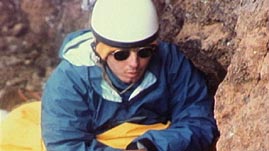Teachers' Domain - Digital Media for the Classroom and Professional Development
User: Preview

Source: Interactive NOVA: "Earth"
In this video segment adapted from Interactive NOVA, mountain-climber Rob Taylor gives a harrowing account of his failed attempt to scale the peak of Africa's Mount Kilimanjaro. Because it is a free-standing mountain — the tallest in the world — climbers must ascend from the base through several climate zones before reaching the arctic summit. After being rescued from a fall near the summit, Taylor thought his worst problems were behind him when an unanticipated consequence of his descent to warmer temperatures presented an equally dangerous challenge.
Mountain Weather: A Climber's Story (Spanish audio) (Video)
Africa's Mount Kilimanjaro is a fascinating study in climate. Located near the equator, it has six distinct ecological zones from base to summit, each with its own climate, flora, and fauna. The conditions that characterize each zone are dictated largely by the combination of temperature, altitude, and moisture. It's these conditions that ultimately influence the types of species suited (or not suited) to inhabit each zone — even for a short time.
Temperatures in Earth's troposphere — the lower atmosphere, up to about 9,100 meters (30,000 ft) at the poles and 16,800 meters (55,000 feet) at the equator — decrease rather predictably with altitude. With each 300 meters (1,000 ft) climbed, air cools by about four or five degrees Fahrenheit. As an air mass approaches a mountain, it is forced upward to an area of lower pressure, and it expands and cools as it rises. Once the air temperature falls to the dew point, water vapor in the air condenses to form clouds that drop precipitation onto windward slopes. As the air passes over the summit, conditions change. Because the air now contains less moisture, conditions on the leeward side are drier. As a result, climbers attempting to reach the summit of mountains like Kilimanjaro may experience very different weather conditions, depending on their ascent route.
Every living thing, from single-celled microbes to megafauna, is adapted to thrive in the conditions that characterize the particular ecosystem it inhabits, whether it is a rainforest, high desert, or host life form. Bacteria, such as those that infect human hosts, can only live and reproduce within a certain range of conditions. Temperature is a key determinant. At lower temperatures, molecules move slower. Enzymes that mediate critical biochemical reactions no longer function, and the increasing viscosity of the cell interior can cause cellular activity to slow or cease. By contrast, in warmer temperatures, molecules move faster, enzymes metabolize more quickly, and cells grow and replicate rapidly.
This explains mountain-climber Rob Taylor's final ordeal — the one he endured after being rescued from Kilimanjaro's arctic summit. His descent through warmer zones reinvigorated bacteria whose activity had slowed inside him during his ascent. As a result, his badly broken and infected leg raged with further swelling.
 Loading Standards
Loading Standards Teachers' Domain is proud to be a Pathways portal to the National Science Digital Library.
Teachers' Domain is proud to be a Pathways portal to the National Science Digital Library.
